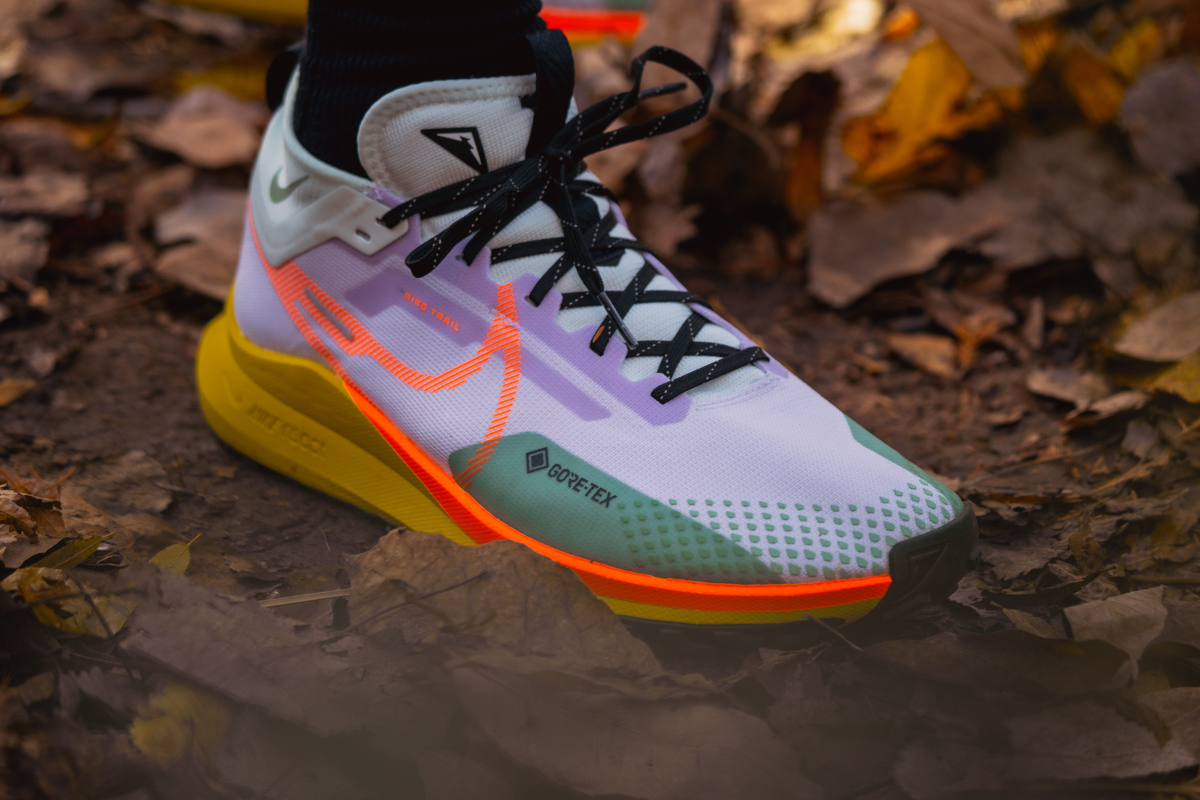
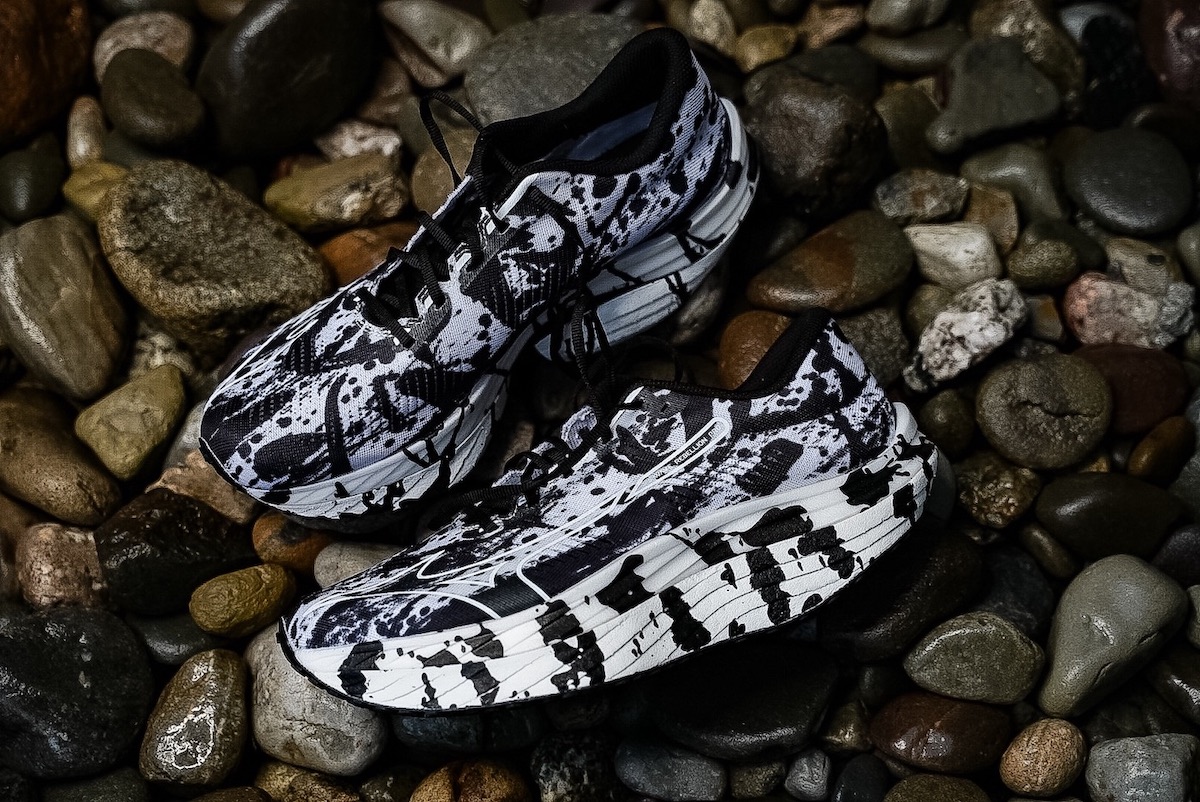
We independently review everything we recommend. When you buy through our links, we may earn a commission.
7.9 oz. (223 g) for a US M9 / US W10.5
39.5 in heel, 35 mm in forefoot (4.5 mm drop), but true stack is ~50 mm
Going f-ing fast on race day
Ultra-bouncy Enerzy Lite Pro top layer on top of a Enerzy Lite bottom layer, carbon-infused plate for propulsion, breathable mesh upper
🟢 Incredibly fast and bouncy
🟢 Shockingly light
🟢 Easily one of the best race day shoes right now, but…
🔴 Toe box is tighter than bark on a log
Available now for $250 (Kakizome colorway drops in March)
THOMAS: It’s been a minute since I put on a Mizuno running shoe that excited me. I need to travel back nearly eight years. Mad Max: Fury Road was in theaters. It was a time before the super shoe revolution. I raced the Charleston Marathon in the Wave Hitogami 2. The Hitogami 2 used lighter foam and had a flexible forefoot but stuck to the Wave Plate like a security blanket. Sure, it’s a fan favorite for runners looking for heel stability, but I would rather have a lighter, more flexible shoe.
The easiest way for us to predict a brand’s downfall is to recognize a gimmick technology on which the brand builds its line. For example, look at Newton Running, which peaked around 2015 with its lugs. On is doing well with its Cloudtec, but we’re already seeing them pivot to a more cosmetic (and less “cloudy”) version. Brands that build on a specific technology and don’t evolve tend to fade.
Mizuno held onto the Wave Plate past its expiration date, and its shoes have become dull and clunky compared to the rest of the market. However, Mizuno would do well to take notes from another brand close to home that’s turned its product line from duds to studs. Yes, Asics has shown Mizuno the playbook on how to get back in the game. Asics revamped its line after sticking to Gel and other visible technologies since the 1990s, and after seeing some stuff that’s coming down the line in the next couple years, we believe Mizuno is looking to do the same.
After running in the latest Mizuno super shoe and speaking with the product manager of the Wave Rebellion Pro, Shunsuke Aoi, I’m confident that Mizuno is on the rise, and we will see exciting products from their team in the next few years.
SAM: I can’t say I’ve always been a fan of modern art. Growing up, I always thought that art was supposed to be clear, clean, and obviously art. As I’ve gotten older, I’ve become a bigger fan of cubism, surrealism, and abstract art styles. I have grown to appreciate seemingly random and unorganized elements mashed together to make something organized and beautiful. Creating a coherent motive out of random elements is something that Mizuno has artfully managed to do here with the Wave Rebellion Pro.
It seems that Mizuno wrote down every criticism they’ve received over previous shoes on a list, then wrote the exact opposite for each point in a new list, and morphed all of those aspects into a carbon-plated racer. Mizuno shoes have often been too heavy, but this was not. They’ve been too firm. This was not. Their shoes have been low to the ground, overly stable, beefed-up plodders better used on a volleyball court than for running. The Mizuno Wave Rebellion Pro is a shoe for running and running fast. Let’s talk about it.

Kakizome colorway of the Mizuno Wave Rebellion Pro
THOMAS: The Mizuno Wave Rebellion Pro’s midsole looks bizarre. Imagine a toe spring but in the heel. I guess you could call it a heel spring. It wouldn’t look crazy if you removed the foam and attached the plate to the upper. Then it would resemble a track spike. The designers thought about what would happen if you added foam to a track spike. So, they took a spike and put it on soft, resilient foam to carry you straight through a marathon. This way, the runner has the perfect surface to run on in a track-inspired design. Mizuno nails the concept. The Wave Rebellion Pro has a unique ride that rewards you for getting up on the forefoot and launching off the toe.
The midsole has three ingredients — the top layer of foam closest to your foot is Mizuno’s Enerzy Lite Pro, which feels like a nitrogen-infused TPU and gives the layer a soft landing with a resilient bounce. Then, the carbon-infused nylon plate has a cutout under the fat pads to relieve stress on the foot over the long distance and enhance optimized stiffness. Adding to the snappiness of the plate is a honeycomb pattern at the midfoot. Finally, we get to the bottom layer of Enerzy Lite, which feels like a Peba-based foam. It’s bouncy but does not compress as much as the Enerzy Lite Pro. The entire outsole is covered with G3 rubber and is as tacky as any other outsole out there. I’d put it up against Adidas’ Continental and Puma’s PumaGrip.
The upper cradles the ankle securely, holds your foot over the midsole and breathes well. The tongue is thin and disappears once you have the shoe on. Although the tongue isn’t gusseted, the double shoelace loops keep it in place.
I did an easy run, two separate speed workouts, and one 17-mile training run with marathon pace intervals in the Mizuno Wave Rebellion Pro. The shoe puts a smile on my face. It stays lively at all paces.*
* Sam runs intervals at a considerably faster pace than most marathoners and may disagree with my comment about “all paces.” I’m saying it worked well at low 6s to high 8-minute paces.
My US M10.5 weighs 232 g. (8.2 oz.).
SAM: First, let’s give some big kudos to Mizuno here. You’ve done it. You have made a shoe that is fun to run in and that I would choose over other high-stack super shoes. This makes me very happy to see. In my opinion, the shining star of this shoe is the midsole. The midsole has two layers, a top layer of Mizuno Enerzy Lite Pro and a larger bottom layer of Mizuno Enerzy Lite.
The Enerzy Lite comes over from the first Wave Rebellion and provides a 22% increase in cushioning and a 35% increase in responsiveness (statistics from Mizuno’s website). I’m not sure what the stats are for the Enerzy Lite Pro, but it’s safe to say that there’s a >22% increase in cushioning and a >35% increase in responsiveness because this stuff is legit. Dual midsole tandems have become more popular lately, and this is another edition. The Lite Pro is plush and bouncy, providing a soft landing for your foot and a springy toe-off at the end. The Enerzy Lite balances the shoe out by providing a firmer ride to carry you through your stride. Like the shades of blue Picasso used during his Blue Period, Mizuno used two similar midsole foams to create a smooth yet engaging ride.
With that out of the way, let’s talk about the elephant in the room. Part of my inspiration for the theme of this review is the colorway of the shoe. I’ll discuss that later. The other inspiration is the wild geometry and build of the shoe. The Wave Rebellion Pro showed up to the party and forgot to bring its heel. A bevel starts around a quarter of the way across the outsole and ends at the back of the insole. According to Mizuno, their Smooth Speed Assist design is “track and field inspired.” My best guess is that the foam is placed more in the midfoot and forefoot to create an aggressive geometry designed to keep you on your toes. There is also a massive cut down the ballerina line and a big chunk missing in the instep, similar to the Adidas super shoe midsoles.
This shoe looks surreal, but like Dali’s The Persistence of Memory, it all combines to work together. The ride of this shoe reminds me of a more stable Prime X that pushes you to run fast. The lack of a heel is not something I noticed, and the large stack is made stable by a carbon-infused nylon plate that also creates more response to your stride. There are no official measurements on the stack, but it is big, bold, and allegedly World Athletics Legal. Like an artist living on the edge of what is expected, Mizuno took a chance with the design of this shoe, and I would argue it works out.
The last positive I want to cover is the weight. This shoe is shockingly light. My US M9.5 was right around 8 oz. For a shoe with this much stack made by Mizuno, I’m very impressed. The cutouts from the midsole, light and breathable engineered upper, and G3 outsole (a PU resin outsole designed to be light with great grip) all work towards making a light and fast shoe. Mizuno’s plate also has a cutout in the forefoot to increase propulsion, which I assume also contributes to saving weight. Being so light complements the ride of the shoe and creates an experience that at no point tires your feet out like Mizuno shoes have in the past been known to do.
Shop Mizuno Wave Rebellion Pro - Men Shop Mizuno Wave Rebellion Pro - Women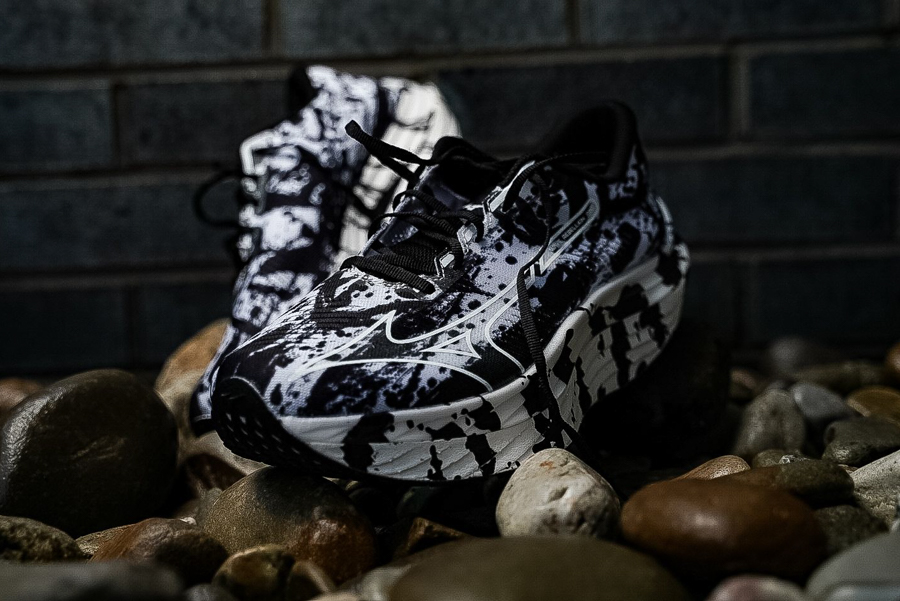
Actual midsole height is around 50 mm
THOMAS: The Mizuno Wave Rebellion Pro fits true to size. In this case, it fits true to size for a race day shoe which should be more fitted than a regular trainer. However, after a 17-mile run, my left big toe was in the hurt locker from rubbing against the front of the shoe. The length of the shoe seems right. My guess is that the volume of the toebox is low.
If you’re a runner that needs stability, this is not your race-day shoe. The hollow arch and medial cutout will not reward heel strikers or pronators. I watched one of our reviewers (cough, Sam, cough) running in the shoe and noticed his foot and ankle collapsing through his stride. It didn’t seem to bother him, though.
SAM: Now time for the negatives. No works of art are perfect, and often the themes and motifs that make them great can also hold them back. The Wave Rebellion Pro’s geometry makes this shoe great but also holds it back. This shoe is amazing at slow paces up into marathon/half marathon paces. But as I picked up the pace, the shape of the midsole became a challenge to run with. On my long and easy-moderate runs, my stride was smooth, and I felt I was being pushed to run faster. On my faster workouts, though, the shape of the shoe began to feel unnatural and made it hard for me to get going. It was almost as if I had hit a point where the shoe could not run faster.
I would highly recommend the Wave Rebellion Pro for runners hoping to use them for marathons or marathon training, but if you’re hoping to do faster workouts or race anything shorter than a half, these are not a shoe that will work out well.
Another issue is the width and length. The Wave Rebellion Pro runs small, barely fits me, and is also quite narrow (sorry, Jarrett). I would size up by half a size to give your foot more room. The lace lockdown is great, and you should have a comfortable feel with more room. I also believe that the stunted feeling I had running at faster paces may be fixed with a larger shoe, which is another plus to sizing up.
The last negative is you cannot corner in the Wave Rebellion Pro. This is a problem endemic to high-stack racers, but if you move too fast into a corner, you will either twist your ankle or break off the precariously-built peninsula of midsole foam in the instep. If sizing up does fix the fast pace issue I had, and the only negative is the shoe’s inability to corner, I think the folks at Mizuno can rest easy after a job well done.
Shop Mizuno Wave Rebellion Pro - Men Shop Mizuno Wave Rebellion Pro - Women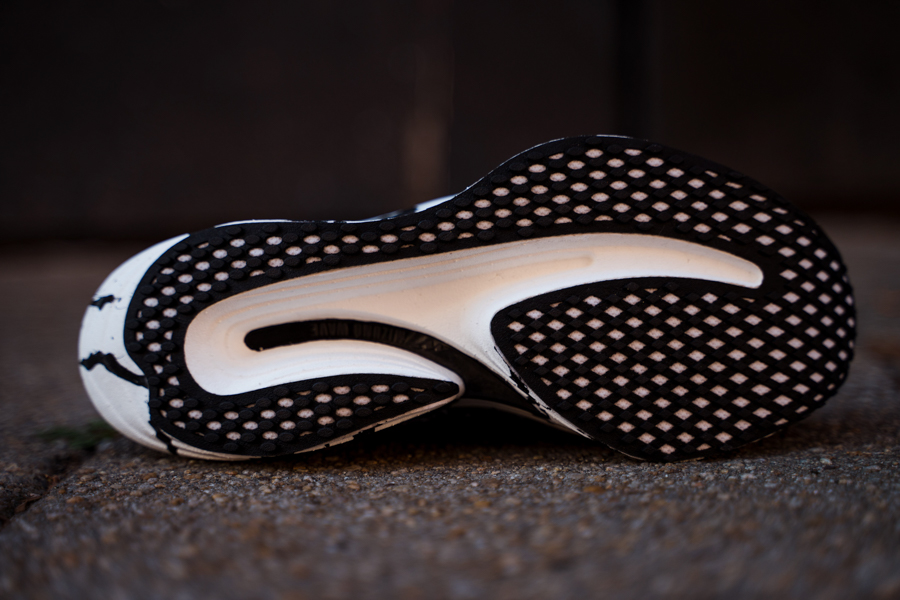
THOMAS: This shoe is exciting. Not just because it’s an excellent option for race day but even more so as a beacon of change at Mizuno. Is this the start of a new direction at a brand that has grown stale for the past five years? I am hopeful. The Mizuno Wave Rebellion Pro hits all the right notes. For the environmentalist, the upper and sock liner are made of 90% recycled materials, and the plant-based wave plate is made from Pebax Rilsan. We can all feel good about that.
SAM: If the first Wave Rebellion was meant to silence the doubts in your head, the Mizuno Wave Rebellion Pro is the voice in your head that’s riding a Kawasaki Ninja with flames shooting out as it flies down the streets of Tokyo. It won’t matter if the doubts are silenced because you’ll be moving too fast and having too much fun to hear them. The calligraphy-inspired colorway is meant to represent runners writing the letters PB at the start of the new year, and with this shoe on your feet, a long-distance personal best should be in the future.
Also, I can’t finish this review without mentioning the sustainable materials used. Captain Planet salutes you, Mizuno. This is not the shoe to knock Nike, Asics, and the like off the mountain. It is a head-turning shoe with a smooth, bouncy ride and a Smooth Speed Assist that pushes you to go fast. If that sounds like something you want, I would give the Wave Rebellion Pro a go.
You can pick up the Mizuno Wave Rebellion Pro for $250 at Running Warehouse (featuring free 2-day shipping and 90-day returns) by using the shop link below.
Have something to say? Leave a Comment
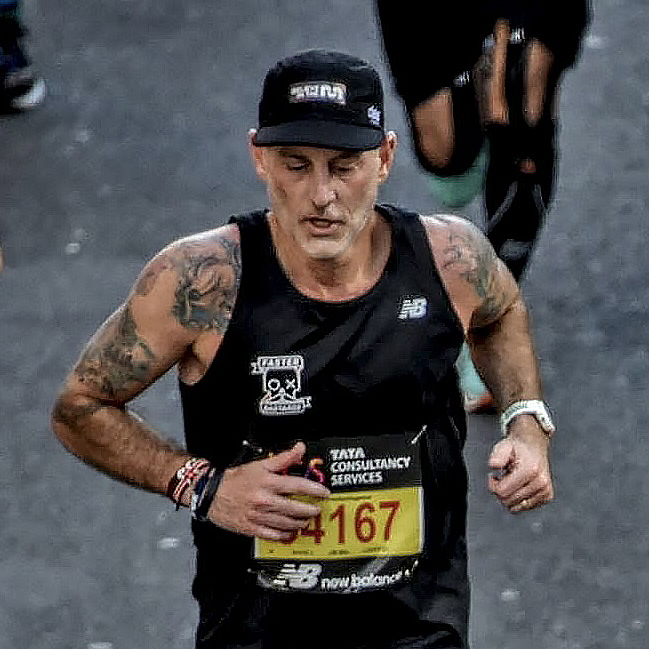
As the founder of Believe in the Run, Thomas’s goal is to help runners pick the shoes and gear that will make their running experience the best that it can be.
More from Thomas
Sam tried every other sport before settling on running as a senior in high school. He’s never looked back. He can be found doing workouts in Patterson Park, talking shop with the Faster Bastards, or hitting long runs on the NCR trail. When not running, Sam is a teacher in the Baltimore City Public School District. His other loves are cooking, coffee, breweries, books, basketball, and alliteration.
More from Sam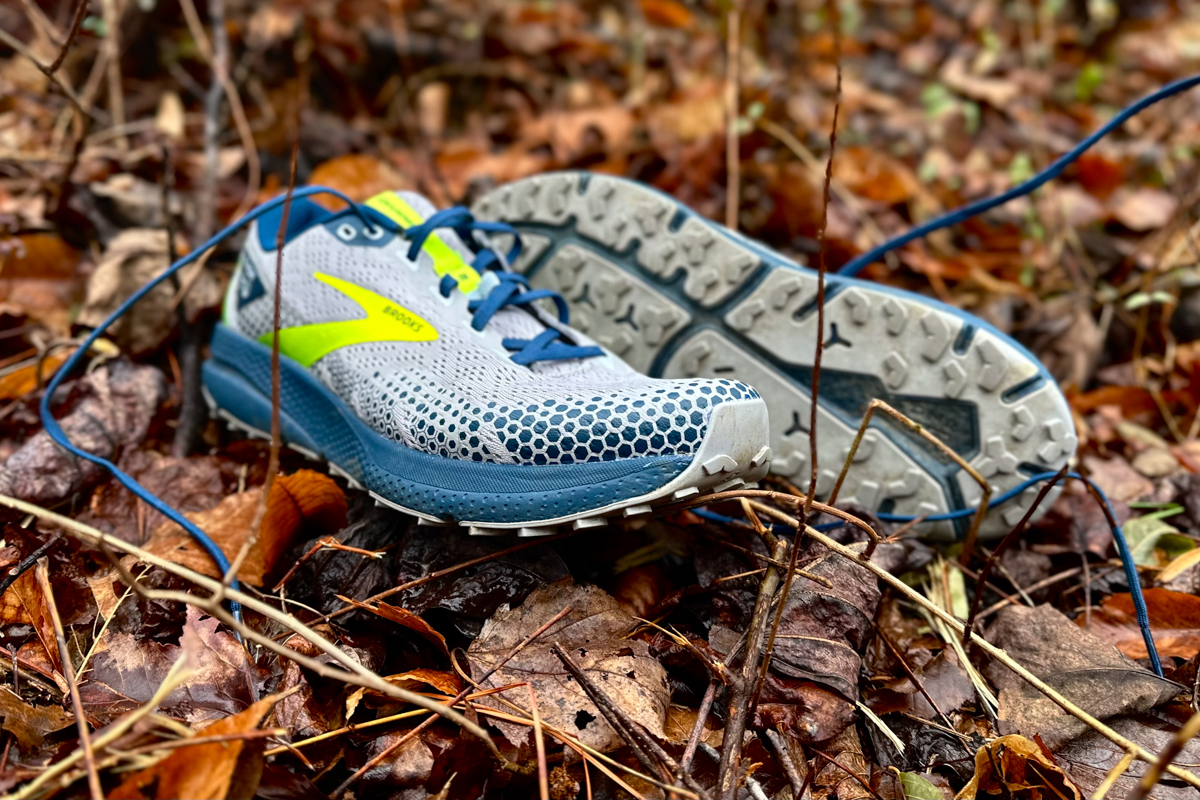
 Read Article
Read Article
